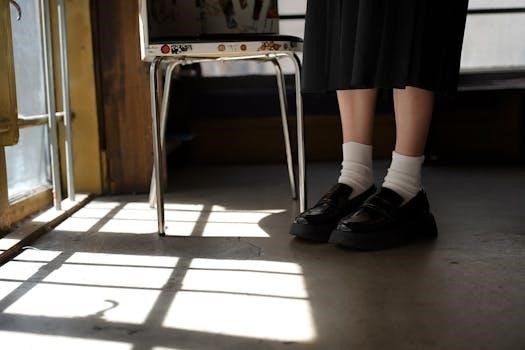La Guerra Sucia Book PDF⁚ An Overview
Nathaniel Kirby’s “La Guerra Sucia” offers a compelling narrative set against Argentina’s “Dirty War.” The PDF provides access to this powerful story‚ blending suspense and historical context.
The Dirty War⁚ Definition and Context
The “Dirty War” (Spanish⁚ Guerra Sucia) refers to the period of state terrorism in Argentina from 1974 to 1983‚ carried out by the military junta. It was a campaign of violence and repression against perceived political opponents‚ including left-wing activists‚ students‚ journalists‚ and anyone deemed subversive. The military and security forces engaged in systematic human rights abuses‚ including kidnappings‚ torture‚ and extrajudicial killings. “La Guerra Sucia‚” as a novel‚ delves into this dark chapter of Argentine history. The book portrays the climate of fear and uncertainty that gripped the nation‚ highlighting the devastating impact on individuals and families. Understanding the historical context of the Dirty War is crucial for grasping the novel’s themes and appreciating the author’s depiction of the era. The civic-military dictatorship aimed to eliminate dissent and maintain control through brutal methods‚ leaving a lasting scar on Argentine society. The book provides a fictionalized yet realistic portrayal of these events.

Nathaniel Kirby’s “La Guerra Sucia”
Nathaniel Kirby’s “La Guerra Sucia” is a compelling novel that explores the harrowing events of Argentina’s Dirty War through a gripping narrative and vivid characters.
Plot Summary and Key Themes
“La Guerra Sucia” follows Leslie Corrales‚ an American journalist and single mother‚ as she journeys to Argentina to investigate the mysterious disappearance of Raul‚ the son of Magdalena Casasnovas. Her investigation delves into the heart of the Dirty War‚ exposing the state terrorism and disappearances orchestrated by the civic-military dictatorship. Key themes explored include the search for truth and justice in the face of oppression‚ the resilience of the human spirit amidst horrific circumstances‚ and the ethical dilemmas faced by individuals caught in political turmoil. The narrative highlights the impact of the Dirty War on families and communities‚ showcasing the courage of those who dared to speak out against the regime. Leslie’s personal journey intertwines with the broader historical context‚ providing a poignant and gripping account of Argentina’s dark past. The book also touches upon themes of motherhood‚ sacrifice‚ and the complexities of international relations during a period of intense political unrest. Through Leslie’s eyes‚ readers witness the human cost of political violence and the enduring struggle for accountability.
Educational Resources and Lesson Plans
Numerous educational resources and lesson plans are available to enhance the study of “La Guerra Sucia” by Nathaniel Kirby. Teachers can find materials online‚ including lesson plans designed to align with educational standards and activities suitable for various learning environments. These resources often focus on the historical context of Argentina’s Dirty War‚ encouraging students to explore the themes of state terrorism‚ disappearances‚ and human rights abuses. Some lesson plans incorporate comprehensible culture units‚ such as those focusing on the Madres de la Plaza de Mayo‚ to provide students with a deeper understanding of the social and political landscape. Activities may include analyzing primary source documents‚ engaging in discussions about ethical dilemmas‚ and creating presentations or essays that demonstrate critical thinking skills. Teachers Pay Teachers also offers a variety of resources created by educators‚ providing a marketplace for original educational materials related to “La Guerra Sucia.” These resources aim to make the complex historical events accessible and engaging for students‚ fostering a deeper understanding of this significant period in Argentinian history. Additionally‚ online study guides and materials can further support student learning and comprehension of the novel.

Availability of “La Guerra Sucia” PDF
The PDF version of “La Guerra Sucia” is accessible through various online platforms‚ offering readers convenient access to Nathaniel Kirby’s novel exploring Argentina’s Dirty War.
Where to Find the Book Online
Finding the “La Guerra Sucia” PDF online involves exploring several avenues. Digital libraries‚ educational resource websites‚ and online bookstores often host the book in PDF format. Scribd‚ for example‚ is a platform where users can upload and share documents‚ including books. Academia.edu is another site where academics share research papers and materials‚ potentially including the book or excerpts from it. Teachers Pay Teachers may offer the book or related resources for educators. When searching‚ use specific keywords like “La Guerra Sucia PDF Nathaniel Kirby” to narrow down your results. Be cautious of unauthorized websites offering free downloads‚ as these may contain malware or violate copyright laws. Always prioritize reputable sources and consider purchasing the book legally to support the author and publisher; Some online retailers may offer a digital version of the book for purchase‚ which can then be downloaded as a PDF. Check online forums and communities related to Spanish language learning or Latin American literature‚ as members may share links to legitimate sources of the PDF. Remember to verify the authenticity and quality of the PDF before downloading to ensure a satisfactory reading experience.

Historical Background of the Dirty War
The Dirty War (1974-1983) was a period of state terrorism in Argentina under a civic-military dictatorship‚ marked by violence‚ disappearances‚ and human rights abuses.
Argentina’s Civic-Military Dictatorship (1974-1983)
Argentina’s Civic-Military Dictatorship‚ which lasted from 1974 to 1983‚ was a dark period characterized by state-sponsored terrorism known as the “Dirty War.” During this time‚ the military junta systematically suppressed political opposition‚ resulting in widespread human rights violations. The regime targeted suspected leftists‚ activists‚ students‚ and anyone perceived as a threat to their power. This era was defined by forced disappearances‚ illegal detentions‚ torture‚ and extrajudicial killings. The exact number of victims remains disputed‚ but estimates suggest that thousands of Argentinians were “disappeared‚” leaving a lasting scar on the nation’s collective memory. The dictatorship aimed to eliminate what it deemed subversive elements from society‚ leading to a brutal crackdown on civil liberties and democratic institutions. The consequences of this period continue to be felt in Argentina‚ as the country grapples with issues of justice‚ accountability‚ and the legacy of state-sponsored violence. Investigations and trials have been ongoing to bring those responsible for the atrocities to justice and to provide closure for the families of the victims. The period represents a stark reminder of the dangers of authoritarianism and the importance of safeguarding human rights.
Thematic Elements in “La Guerra Sucia”
Kirby’s novel explores themes of political violence‚ disappearances‚ and the struggle for justice during Argentina’s Dirty War. It highlights the human cost of state terrorism.
Disappearances and State Terrorism
One of the core themes of “La Guerra Sucia” revolves around the forced disappearances carried out by the Argentine government during the Dirty War (1974-1983). These disappearances were a key tactic of state terrorism employed by the civic-military dictatorship‚ targeting individuals suspected of being political opponents‚ activists‚ or simply those deemed subversive. The novel likely delves into the devastating impact of these disappearances on families and communities‚ exploring the uncertainty‚ fear‚ and grief experienced by those left behind. It may also touch upon the legal and ethical complexities surrounding the issue‚ including the struggle for justice and accountability in the aftermath of the dictatorship. The book could illustrate the systematic nature of the disappearances‚ highlighting the involvement of military and security forces in the abduction‚ torture‚ and murder of thousands of people. Through its characters and plot‚ “La Guerra Sucia” aims to shed light on the dark realities of state terrorism and its lasting consequences on Argentine society. It serves as a reminder of the importance of remembering and confronting the past to prevent such atrocities from happening again‚ underlining the need for truth‚ justice‚ and reparations for the victims and their families‚ promoting a culture of respect for human rights and democratic values.

Additional Resources for Studying “La Guerra Sucia”
To enhance understanding of “La Guerra Sucia‚” explore online guides‚ historical context‚ and lesson plans that deepen insights into the novel’s themes and setting.
Online Study Guides and Materials
Numerous online resources are available to aid in the study of Nathaniel Kirby’s “La Guerra Sucia.” These materials often include chapter summaries‚ character analyses‚ and explorations of the historical context surrounding Argentina’s Dirty War. Teachers Pay Teachers offers a variety of educational resources created by educators‚ focusing on different aspects of the book‚ such as vocabulary‚ comprehension‚ and thematic elements. Quizlet provides flashcards and study sets to help students memorize key terms‚ characters‚ and plot points. Academia.edu hosts research papers and scholarly articles that offer deeper insights into the novel’s themes and historical significance. Some online platforms also offer lesson plans and activities designed to integrate the book into classroom curricula‚ encouraging critical thinking and engagement with the text. These study guides and materials can be invaluable for students and educators seeking a comprehensive understanding of “La Guerra Sucia” and its historical backdrop‚ providing tools to analyze the novel’s literary merits and its portrayal of a tumultuous period in Argentine history.

No Responses